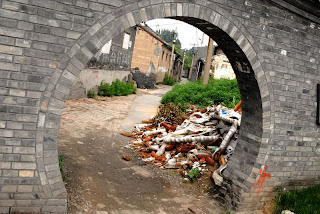 The bulk of the Beijing houses used to consist of the "siheyuans" (houses with a court yard in the middle, housing whole families), which are (were) situated along the so called hutongs, (alleys). As of the middle and late eighties, those traditional, cosy houses have increasingly been replaced by modern buildings. Many hutongs were and are cramped, damp, cold and noisy, while many of them still lack private, modern bathrooms, forcing the dwellers to use common utilities. Common bathrooms in China can be pretty disastrous, though most chinese seem to overlook these horrors.
The bulk of the Beijing houses used to consist of the "siheyuans" (houses with a court yard in the middle, housing whole families), which are (were) situated along the so called hutongs, (alleys). As of the middle and late eighties, those traditional, cosy houses have increasingly been replaced by modern buildings. Many hutongs were and are cramped, damp, cold and noisy, while many of them still lack private, modern bathrooms, forcing the dwellers to use common utilities. Common bathrooms in China can be pretty disastrous, though most chinese seem to overlook these horrors.
Alas, government seems to have little patience with people who do not like to leave their hutongs, and there are many stories about people being intimidated out of their houses and businesses. If one sees with what kind of Corbusier-style nightmares the hutong dwellings are being replaced with, one might start to doubt about the sanity of the whole project. But is humanly proportioned architecture still feasable in Chinese cities, considering their huge population (growth)? It might be a privilge of citizens of stagnating backwaters like Holland to endlessly protest new and ambitious building projects.However, there seems to be a rising sense of the need to preserve the monuments like the hutongs. There are still quite some patches of them around in Beijing. But Chinese don't seem to share the western respect of truly old artefacts. As a matter of fact, they seem to prefer a sort of Disneyfiyed copy of the old original. Close to the Tieanmen Square, a "brand new hutong" district arose smack in the middle of the remains of an old hutong district, with still may original parts around, though most of them hidden behind walls.



Melon plants in a hutong




No comments:
Post a Comment